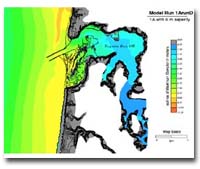| |
 
Tsunamis are a series of very long waves generated by any rapid, large-scale
disturbance of the sea. Most are generated by sea floor displacements
from large undersea earthquakes. Tsunamis can cause great destruction
and loss of life within minutes on shores near their source, and some
tsunamis can cause destruction within hours across an entire ocean
basin.
Most tsunamis occur in the Pacific region but they are known to happen
in every ocean and sea. Although infrequent, tsunamis are a significant
natural hazard with great destructive potential. They can only be
dealt with effectively through programs of warning, mitigation, and
education. |

•
International
Tsunami Information Center - The
International Tsunami Information Center was established in
1965 by the IOC (Intergovernmental Oceanographic Commission)
of UNESCO (United Nations Educational, Scientific and Cultural
Organization). ITIC maintains and develops relationships with
scientific research and academic organizations, civil defense
agencies, and the general public in order to carry out its mission
to mitigate the hazards associated with tsunamis by improving
tsunami preparedness for all Pacific Ocean nations.
• Tsunami
Event Database - provides information on tsunami events
from 49 B.C. to the present in the Mediterranean and Caribbean Seas, and the Atlantic,
Indian, and Pacific Oceans. The data are contained in two files.
The Event database contains information on the tsunami such
as the cause of the tsunami, the source location, the magnitude
and intensity of the tsunami, etc. The Runup database contains
information on locations where tsunami effects occurred.
These data
are available on a two-volume CD collection of seismicity catalogs
containing data for more than four million earthquakes from
2100 B.C. to 1995 A.D.
present in the Mediterranean and Caribbean Seas, and the Atlantic,
Indian, and Pacific Oceans. The data are contained in two files.
The Event database contains information on the tsunami such
as the cause of the tsunami, the source location, the magnitude
and intensity of the tsunami, etc. The Runup database contains
information on locations where tsunami effects occurred.
These data
are available on a two-volume CD collection of seismicity catalogs
containing data for more than four million earthquakes from
2100 B.C. to 1995 A.D.
• NOAA's
Tsunami Research Program - seeks
to mitigate tsunami hazards to Hawaii, California, Oregon, Washington
and Alaska. Research and development activities focus on an
integrated approach to improving tsunami warning and mitigation.
•
Center
for Tsunami Inundation Mapping Efforts
- assists
the Pacific States in the development of maintenance of maps
which identify areas of potential tsunami flooding.
•
Natural
Hazards Slide sets - pictures of tsunami damage
•
IOC
Tsunami Glossary - terms,
classification
•
Tsunami
Modeling and Forecasting
|
|
|

